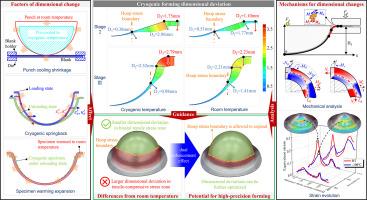球形外壳在低温成形过程中的尺寸变化和回弹
IF 7.1
1区 工程技术
Q1 ENGINEERING, MECHANICAL
International Journal of Mechanical Sciences
Pub Date : 2024-10-04
DOI:10.1016/j.ijmecsci.2024.109757
引用次数: 0
摘要
低温成形已被开发用于制造薄壁曲面铝合金部件,其最终尺寸会受到低温收缩和回弹的影响。因此,对低温成形中球形外壳的尺寸变化进行了理论和实验研究。通过讨论低温成形过程,阐明了影响尺寸变化的因素。通过分析应力分布,定性地揭示了回弹行为。建立了低温尺寸测量装置,以定量评估冲压冷却、回弹和试样恢复到室温的成形过程中的尺寸变化。建立了弹性模量和膨胀系数的温度相关性模型,以定量计算热胀冷缩对试样和冲头尺寸的影响。理论分析结果表明,深度减小和开口扩张是由低温回弹产生的,由不同变形区域的径向应力、环向应力和弯矩决定。由于径向变形增大和弯曲变形减小,双轴拉伸应力区的低温回弹减少了 37.8%。相反,拉伸-压缩应力区的低温回弹增加了 30.8%。深度方向上的冲头冷却收缩和试样升温膨胀可以减少回弹造成的尺寸偏差,但在箍筋方向上却会造成相反的影响。利用提出的模型可以有效预测膨胀和收缩,误差小于 16%。双轴拉伸应力的变形区域可以通过在低温下显著提高的硬化能力而扩大,这有利于提高变形均匀性并进一步减少回弹。因此,低温成形为铝合金深腔薄壁部件的精密制造提供了巨大潜力。本文章由计算机程序翻译,如有差异,请以英文原文为准。

Dimensional change and springback of spherical shell in cryogenic forming
Cryogenic forming has been developed to manufacture thin-walled curved aluminum alloy components, whose final dimensions are affected by cryogenic shrinkage and springback. Therefore, dimensional changes of spherical shell in cryogenic forming were studied theoretically and experimentally. The cryogenic forming process was discussed to elucidate the factors affecting the dimensional change. The stress distribution was analyzed to qualitatively reveal the springback behavior. Cryogenic dimensional measurement devices were built to quantitatively evaluate the dimensional changes in the forming processes of punch cooling, springback, and specimen restoration to room temperature. The temperature dependencies of the elastic modulus and expansion coefficient were modeled to quantitatively calculate the effect of thermal expansion and contraction on the dimensions of specimen and punch. The theoretical analysis results indicate that depth reduction and opening expansion are produced by cryogenic springback, determined by the radial stress, hoop stress, and bending moment in different deformation regions. The cryogenic springback in the biaxial tensile stress zone was reduced by 37.8 % owing to the increasing radial deformation and decreasing bending deformation. In contrast, cryogenic springback in the tensile-compressive stress zone increased by 30.8 %. The punch cooling shrinkage and specimen warming expansion in depth direction can reduce for the dimensional deviation caused by springback but cause the opposite effect in hoop direction. Expansion and shrinkage were effectively predicted using the proposed model, with an error of less than 16 %. The deformation region of the biaxial tensile stress can be enlarged by the significantly improved hardening ability at cryogenic temperature, which benefits enhancing deformation uniformity and further reduces springback. Therefore, cryogenic forming offers considerable potential for the precision manufacturing of aluminum alloy deep-cavity thin-walled components.
求助全文
通过发布文献求助,成功后即可免费获取论文全文。
去求助
来源期刊

International Journal of Mechanical Sciences
工程技术-工程:机械
CiteScore
12.80
自引率
17.80%
发文量
769
审稿时长
19 days
期刊介绍:
The International Journal of Mechanical Sciences (IJMS) serves as a global platform for the publication and dissemination of original research that contributes to a deeper scientific understanding of the fundamental disciplines within mechanical, civil, and material engineering.
The primary focus of IJMS is to showcase innovative and ground-breaking work that utilizes analytical and computational modeling techniques, such as Finite Element Method (FEM), Boundary Element Method (BEM), and mesh-free methods, among others. These modeling methods are applied to diverse fields including rigid-body mechanics (e.g., dynamics, vibration, stability), structural mechanics, metal forming, advanced materials (e.g., metals, composites, cellular, smart) behavior and applications, impact mechanics, strain localization, and other nonlinear effects (e.g., large deflections, plasticity, fracture).
Additionally, IJMS covers the realms of fluid mechanics (both external and internal flows), tribology, thermodynamics, and materials processing. These subjects collectively form the core of the journal's content.
In summary, IJMS provides a prestigious platform for researchers to present their original contributions, shedding light on analytical and computational modeling methods in various areas of mechanical engineering, as well as exploring the behavior and application of advanced materials, fluid mechanics, thermodynamics, and materials processing.
 求助内容:
求助内容: 应助结果提醒方式:
应助结果提醒方式:


